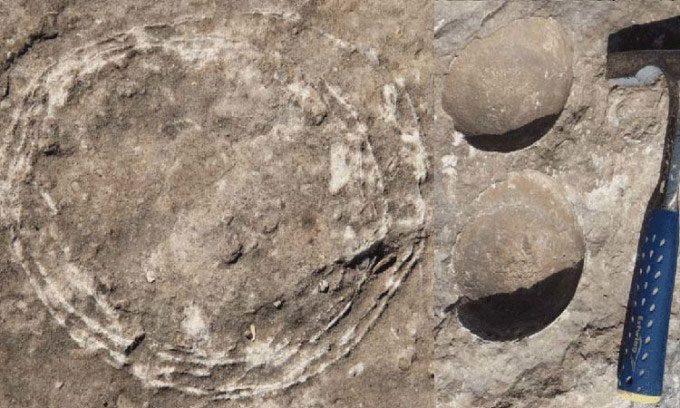Scientists Discover a Fossilized Dinosaur Egg Inside Another Dinosaur Egg in a Titanosaurid Nest.
The phenomenon of ovum-in-ovo occasionally occurs in bird species, such as chickens, due to their specialized uterine structure, making it more likely than in reptiles. However, scientists have for the first time discovered a fossilized dinosaur egg nestled within another egg, as reported by IFL Science on June 20. This marks the first instance of such a finding in reptiles in general.

Fossilized egg within an egg (left) and two other dinosaur eggs (right) found in India. (Photo: H Dhiman/Scientific Reports)
The discovery site is the Bagh Dinosaur Fossil National Park in Madhya Pradesh, India. Here, the research team identified 52 nests belonging to Titanosaurids. One of these nests contained 10 eggs, including the egg within an egg, which had two layers of shells.
The fossilized egg within an egg belongs to the Titanosaurid genus (meaning “lizard-like”), a group of Sauropoda (long-necked dinosaurs), providing clues about the oviduct morphology of this species. It is likely that they had adaptations similar to birds, allowing for sequential egg-laying. This suggests that Titanosaurid dinosaurs may have also laid eggs in this manner.
Reptiles like sea turtles lay eggs after they drop from the uterus, sometimes producing hundreds of eggs in a single nesting event. In contrast, birds that lay eggs sequentially can produce unusual double eggs. Crocodiles have a specialized uterus and a segmented structure similar to birds but follow the reptilian method of laying all eggs at once.
The new research is detailed in the journal Scientific Reports. “The discovery of an egg within an egg in a Titanosaurid nest indicates that their oviduct morphology is similar to that of birds, opening up the possibility that this group of dinosaurs could lay eggs sequentially. This new finding emphasizes that the phenomenon of ovum-in-ovo is not exclusive to birds and shows that lizard-like dinosaurs share reproductive behaviors similar to other Archosauria,” the research team stated.
Scientists need to conduct further studies to draw definitive conclusions, but this surprising discovery of an egg within an egg suggests that this peculiar phenomenon is not limited to birds. The new finding also indicates that lizard-like dinosaurs share more similarities with birds and crocodiles than with non-Archosaurian reptiles, becoming a “goldmine” for research in evolutionary biology.





















































